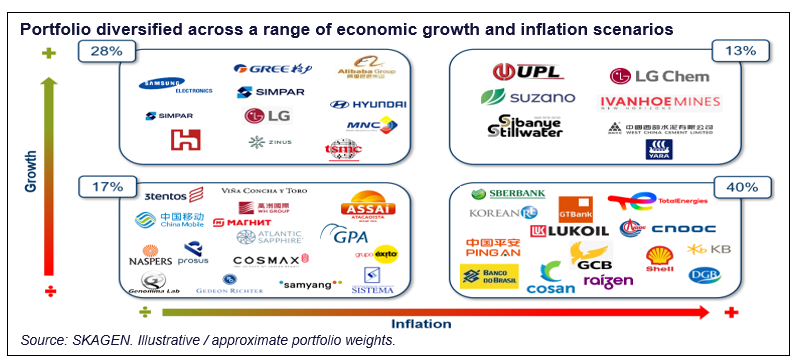Against a backdrop of wavering emerging market performance, SKAGEN Kon-Tiki remains in full sail. The fund has generated EUR returns of 8.9% year-to-date, 6.3% ahead of the broader EM index, and to underscore its consistency is also outperforming over 1, 3 and 5 years (by 13.0%, 3.6% and 0.9%, respectively)[1].
Most of the fund's market-beating returns this year have been driven by good stock picking, particularly in China where the team's contrarian and valuation-driven approach continues to pay off. Fredrik Bjelland, Kon-Tiki's Lead Portfolio Manager, explains: "CNOOC is the largest contributor; the state-owned energy company is a world-class operator which pays out most of its excess earnings to shareholders. Compatriot Foxconn Industrial Internet has been the next best performer; the world’s largest electronics manufacturer is supplier to many of the world's leading tech companies such as Apple and has attractive AI exposure via its cloud computing and server businesses."
This positive performance has carried over from 2022 when China was the best country contributor, also as a result of strong stock selection. Chinese companies make up the three largest portfolio positions (CNOOC, Ping An and Alibaba) although Kon-Tiki's overall China weighting has fallen since the start of the year following the sale of Foxconn Industrial Internet, China Life and Hisense Home Appliances which all hit our share price targets.
Differentiated portfolio
The portfolio continues to contain high quality but undervalued companies. It currently trades around 50% cheaper than the MSCI EM Index on both a P/E and P/B basis, with weighted upside above 50% over a two-year horizon. Despite discounted valuations, the holdings have delivered similar return on equity (ROE) to the benchmark over the last three years[2], highlighting the team's "value-for-money" approach rather than low prices alone.
SKAGEN Kon-Tiki is similarly well-placed against its peers. According to Copley Fund Research, the portfolio ranks close to the top quartile among 370 global emerging market funds for consensus earnings growth in 2024 while being in the cheapest valuation percentile on a P/E and P/B basis[3]. Because of these characteristics, SKAGEN Kon-Tiki is weakly correlated with other EM funds, making it a good diversifier for clients.
The fund remains very different to the EM index with an Active Share of 90%. This is largely due to many of its holdings being off-benchmark – the portfolio is biased towards smaller companies and has around 16% of assets invested in developed and frontier market listed stocks – but also the position sizing of index constituent holdings.
SKAGEN Kon-Tiki contains 50 companies – in line with its 40-70 target range – spread across 20 countries. Seven new holdings have entered the fund in 2023 with two (Simpar and Tres Tentos) following our trip to Brazil at the start of the year. Brazilian companies in total represent 16% of the fund, up from 11% at the start of the year, which is its third largest country exposure after China (27%) and South Korea (24%). Although driven by bottom-up stock selection, the portfolio's broad geographic diversification offers top-down protection against the heightened geopolitical risks faced by EM investors.
The holdings are also spread across nine different sectors with consumer discretionary (21%) the largest, followed by financials and energy (20% each). The latter two sectors have historically outperformed in stagflationary environments, although the portfolio is well-positioned for a range of different macroeconomic scenarios (see below).

Outlook uncertainty
Emerging markets have lagged developed ones by over 10 percentage points so far in 2023[4]. This has been driven by the AI-led strength of large US tech stocks and weak performance of Chinese equities which make up 30% of the EM index and have fallen 8.5% year-to-date[5].
Despite the country's sluggish re-opening from COVID, Bjelland believes that concerns China is collapsing seem off the mark: "China has few overseas financial obligations, i.e. international debt and trade payments and large currency reserves, which indicates a degree of stability and the capacity to weather more challenging economic conditions."
As such, the country continues to throw up interesting investment opportunities, as Bjelland explains: "While the growing trade and technology war with the US poses significant challenges, it will likely lead to increased focus on developing domestic capabilities and champions, particularly within technology hardware. We may also see a greater emphasis on trade and value chains across emerging markets economies. This will no doubt challenge global supply chains as we know them today."
Against this uncertain backdrop, which could make earnings more volatile, prices paid become even more important. Emerging markets are currently priced at a 30% discount to developed ones on P/E basis – well below the 20-year average – while the P/B differential is at its highest since the dot com bubble at the turn of the century[6]. With Kon-Tiki priced at an even greater discount and the portfolio carefully positioned for a range of outcomes – both positive and negative – the fund looks well-placed to continue outperforming for clients wherever emerging markets are heading next.
All information as at 31/08/2023 unless stated.
[1] As at 30/09/2023 in EUR net of fees.
[2] Source: SKAGEN: Based on top 35 holdings (3-year ROE: 12.0%) vs. MSCI EM Index (3-year ROE: 11.6%).
[3] Source: Copley Fund research as at 31/08/2023. EPS growth 23-24: 36.1%, P/E: 8.2x, P/B 0.9x.
[4] Source: MSCI in EUR. As at 30/09/2023. MSCI World +10.5%, MSCI EM +0.4%.
[5] Source: MSCI China in EUR. As at 30/09/2023.
[6] Source: Bloomberg. As at 31/08/2023.




